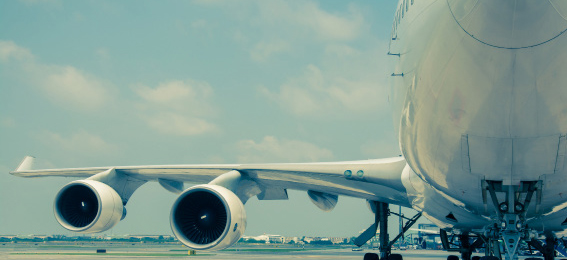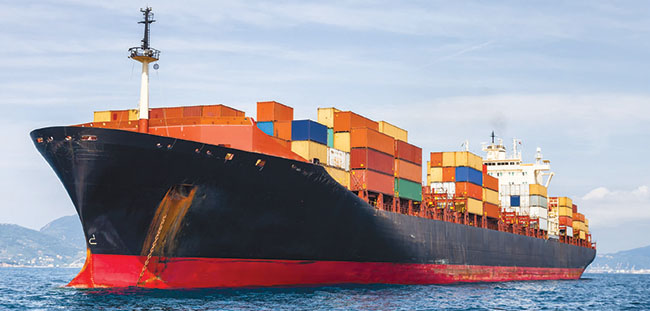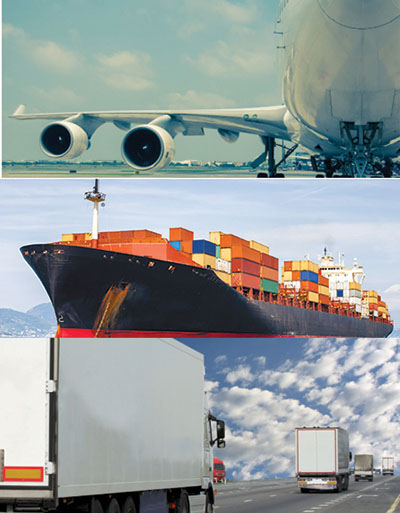Top 25 Freight Forwarders 2017: Digitization & E-Commerce continue to reshape the marketplace
The global freight forwarding market has grown by 2.7% in real terms since this time last year, but owing to a continuation of excess capacity issues and lower average oil prices, rates continue to fall in both air and sea freight. Forwarders now need to ramp up the value-add visibility services in an effort to boost revenues and keep shippers smiling.
Over the course of 2016, real revenue and volume growth in the air and sea freight forwarding markets was remarkably similar globally, but this disguises significant differences across important countries and regions, say analysts who keep a close eye on the market.
For example, airfreight forwarding growth in China is thought to have been robust this past year, while sea freight growth was much weaker. Conversely, the United States saw moderate expansion in sea freight as air cargo growth faltered over the same period.
Looking ahead to the next 12 months, the market is anticipated to grow at a real compound annual growth rate of 4.1%, as global trade volume growth accelerates. Meanwhile, logistics managers moving freight globally should plan their budgets accordingly.
According to the new “Global Freight Forwarding 2017 Report” compiled by the London-based think tank Transport Intelligence (Ti), a continuation of excess capacity issues and lower average oil prices in 2016 led rates to fall in both air and sea freight, meaning most forwarders reported lower year-on-year revenues.
Top 25 Global Freight Forwarders
Ranked by 2016 Logistics Gross Revenue/Turnover and Freight Forwarding Volumes*
| A&A Rank | Provider | Gross Revenue (US$ M) | Ocean TEUs | Air Metric Tons |
|---|---|---|---|---|
1 |
DHL Supply Chain & Global Forwarding |
26,105 |
3,059,000 |
2,081,000 |
2 |
Kuehne + Nagel |
20,294 |
4,053,000 |
1,304,000 |
3 |
DB Schenker |
16,746 |
2,006,000 |
1,179,000 |
4 |
DSV |
10,073 |
1,305,594 |
574,644 |
5 |
Sinotrans |
7,046 |
2,950,800 |
532,400 |
6 |
Panalpina |
5,276 |
1,488,500 |
921,400 |
7 |
Nippon Express |
16,976 |
550,000 |
705,478 |
8 |
Expeditors |
6,098 |
1,044,116 |
875,914 |
9 |
UPS Supply Chain Solutions |
6,793 |
600,000 |
935,300 |
10 |
CEVA Logistics |
6,646 |
681,600 |
421,800 |
10 |
GEODIS |
6,830 |
690,000 |
330,000 |
11 |
Bolloré Logistics |
4,670 |
856,000 |
569,000 |
12 |
Hellmann Worldwide Logistics |
3,443 |
902,260 |
576,225 |
13 |
Kintetsu World Express |
4,373 |
556,640 |
495,947 |
14 |
Yusen Logistics |
4,169 |
633,056 |
332,389 |
14 |
Kerry Logistics |
3,097 |
1,055,600 |
282,200 |
15 |
DACHSER |
6,320 |
481,400** |
272,100 |
16 |
C.H. Robinson |
13,144 |
485,000 |
115,000 |
17 |
Agility |
3,576 |
513,500 |
372,700 |
18 |
Hitachi Transport System |
6,273 |
430,000 |
230,000 |
19 |
Toll Group |
5,822 |
542,000 |
114,000 |
20 |
Damco |
2,500 |
659,000 |
190,000 |
21 |
XPO Logistics |
8,638 |
131,500 |
72,300 |
22 |
Logwin |
1,095 |
600,000 |
140,000 |
23 |
NNR Global Logistics |
1,676 |
146,278 |
286,897 |
“While air and sea volume growth picked up a bit in 2016, most forwarders experienced declining revenues on the back of substantial rate declines,” says David Buckby, an economist at Ti. “However, and as usual in such circumstances, the fall in forwarder sell rates did not match the drop in their buy rates, leading to improved gross profit margins.”
Over the medium term, Buckby expects growth to pick up in line with higher global trade volume forecasts in 2018, though risks are tilted to the downside due to factors such as political uncertainty and continued trade protectionism rhetoric.
Deep dive into the market
The Ti report also explores the performance of the top players against the rest of the market; disintermediation; regionalization; vertical sector opportunities and the effectiveness of online booking platforms.

On profitability performance, survey results indicate that excluding the impact of volume and rate changes, margin pressures for forwarders will intensify over the next five years. Indeed, researchers feel that with investment in technology and offering new or more value-added services, middlemen will develop more successful strategies to sustain margins. In addition, it appears that conventional forwarders are set to lose volume share to other parties like smaller, more technologically savvy 3PLs, but the threat may be “asymmetrical” for air and sea.
A deep dive into the world of freight forwarding technology reveals the disruption caused by digitization, changes to the competitive landscape, and, ultimately, whether forwarders can adapt and survive the upheaval being caused by the continued evolution of the digital supply chain.
“The research we’ve conducted indicates that there’s substantial demand for online interfaces that allow forwarders to better serve shippers,” says Ti analyst Alex Le Roy. “Nonetheless, it’s clear that the scope of these solutions, in terms of geographic coverage for example, needs to broaden in order for them to deliver value. This will occur, but we are now bearing witness to a race for scale amongst the start-ups.”
John Manners-Bell, CEO of Ti, also asserts that the forwarding sector is facing a challenging time, not least because the global economic environment has remained volatile and difficult to anticipate—though this was nothing new, and the sector has always coped well in such circumstances. He warns, however, that structural challenges such as trends toward regionalization and near-sourcing, coupled with greater technological demands, will prove more difficult to manage.
“Political, economic and technological pressure will continue to shape the industry in the coming year,” says Manners-Bell. “One thing is certain, whether large or small, freight forwarders will need to remain agile if they are to flourish in an uncertain and complex world.”
Digitize or die
The Ti report mirrors much of what’s contained in a recent survey conducted by the consultancy Logistics Trends & Insights. According to “The Evolving Freight Forwarding Market 2017,” digitization is looming large in the immediate future.
Cathy Morrow Roberson, president of the consultancy, maintains that the advent of non-traditional players riding the wave of e-commerce growth—such as Amazon, Alibaba, and the many new tech-based startups—are changing the face of forwarding.
“The digitization of supply chains has forced many traditional forwarders into investing and automating their processes,” says Morrow Roberson. “The new generation entering the logistics markets have grown up with the laptops and smartphones and expect business transactions to be the same or just as easy as ordering a pair of shoes from Amazon.”

When asked what improvement will be utilized the most over the next five years, 58% of responding shippers named “digitization,” with 92% of survey respondents saying “digitization adds value.” Furthermore, says Morrow Roberson, 58% of survey respondents view online freight marketplaces as an opportunity for traditional forwarders.
“In fact, we’re seeing partnerships being established between traditional forwarder and non-traditional,” says Morrow Roberson. “DB Schenker and uShip, for example. Schenker acquired an equity stake and is using uShip within the European road freight market. Drive4Schenker uses uShip technology to connect the some 30,000 transport partners in the European land transport network to their freight.”
Morrow Roberson adds that partnering with an online freight marketplace allows a traditional forwarder to offer a digital solution in a faster manner. As an example, she points out that DHL introduced its online marketplace—CILLOX—that matches full truckload and less-than-truckload shipments with available transportation providers.
“A big plus for digitization is that it levels the playing field for small- to medium-size forwarders as well as the larger ones,” says Morrow Roberson. “And it’s not only forwarders, but also shippers of all sizes. Shippers can take advantage of numerous online marketplaces, such as Freightos, to obtain a rate, book the freight and track it from beginning to end.”
According to Morrow Roberson, a drawback to many, if not all of these marketplaces, is that not all trade lanes are included; so shippers will need to choose wisely which marketplace to use and remember to compare rates among all of them, including those of traditional forwarders.
“The big question to ask,” cautions Morrow Roberson, “is as if the rates are published or negotiated.”

Margin watch
Dr. Zvi Schreiber, CEO of Freightos, a technology provider focused on instant freight quotes for freight forwarders and shippers, admits that the last quarter “ended on a somber note for digitization” due to cyber-attacks that temporarily crippled some of the major global forwarders.
“However, the shipping community will remain vigilant in safeguarding the progress we’ve made toward transparency,” says Schreiber.
The most recent Freightos newsletter, “LogTech Review: Q2 2017,” notes that during the second half of June, Amazon and Alibaba both held conferences in the United States, appealing to small and midsize businesses selling on their platform.
“While Alibaba was advocating sales to China as Amazon encouraged cross-border importing, both were clearly pursuing a small- to medium-sized business focus, as Big Box retailers continue to struggle,” says Schreiber.
For enterprise forwarders and carriers, the marching orders for the second quarter appeared to be freight visibility, as a number of companies unveiled solutions to enhance cross-supply chain visibility of shipments. The last-mile drone delivery space stayed hot, both in the air and on the ground. Meanwhile, Uber Freight formally launched its product, while continuing to face strong competition from other on-demand trucking startups.
“The second quarter of this year was a strong quarter for visibility technology,” says Schreiber, “particularly for DHL’s varied divisions.” DHL Global Forwarding launched Ocean View, which offers real-time updates on maritime shipments; DHL SupplyWatch, an AI program for identifying supply chain disruptions; and Saloodo, an online trucking marketplace.
Meanwhile, DP World also released a container visibility solution in the UK, as French startup Traxens unveiled a smart freight train tracking solution. In Germany, Panalpina launched a pilot ocean shipment management system. “Finally, CHAMP took tracking further with voice-based air cargo tracking via Alexa,” says Schreiber. “And the timing couldn’t be better.”
Brandon Fried, executive director of the Air Forwarders Association (AfA), agrees with Schreiber positive take on the innovation being pushed into the market, noting that while air cargo volumes have increased, margins remain depressed and most of AfA members are looking forward to more tech-driven opportunities in which profitability may improve.
“One influencing factor to consider is the growth of capacity we’ve seen over the past couple of years, keeping pricing at lower levels,” says Fried. “This increase in space is attributable to the large amount of new and efficient wide-body aircraft, each with generous belly space flying the popular trade lanes.”
Another significant factor inhibiting this growth in many cases lies with lower customer pricing agreements that may no longer reflect today’s market conditions. Once these contracts expire, says Fried, prices and margin should improve overall.
“However, new transport pricing agreements alone will not assure increased profitability, and this is why forwarders must be searching for more operational efficiencies that only technology can provide,” says Fried. “People still play a crucial role in our business, but technology will help them work smarter and provide an improved customer experience.”

Article Topics
Special Reports News & Resources
Warehouse/DC Automation & Technology: It’s “go time” for investment 31st Annual Study of Logistics and Transportation Trends Warehouse/DC equipment survey: It’s “go time” for investment Global Logistics/3PL Special Digital Issue 2022 Motor Freight 2022: Pedal to the Metal Top 50 Trucking Companies: The strong get stronger 2019 Top 50 Trucking Companies: Working to Stay on Top More Special ReportsLatest in Logistics
Diesel back over $4 a gallon; Mideast tensions, other worries cited Four U.S. railroads file challenges against FRA’s two-person crew mandate, says report XPO opens up three new services acquired through auction of Yellow’s properties and assets FTR’s Trucking Conditions Index weakens, due to fuel price gains U.S. rail carload and intermodal volumes are mixed, for week ending April 6, reports AAR LM Podcast Series: Examining the freight railroad and intermodal markets with Tony Hatch Supply Chain Stability Index sees ‘Tremendous Improvement’ in 2023 More LogisticsAbout the Author
Subscribe to Logistics Management Magazine

Find out what the world's most innovative companies are doing to improve productivity in their plants and distribution centers.
Start your FREE subscription today.
April 2023 Logistics Management

Latest Resources
















